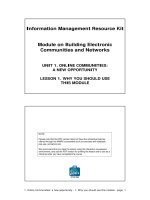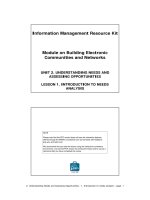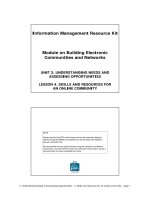UNIT 2. UNDERSTANDING NEEDS AND ASSESSING OPPORTUNITIES LESSON 2. CREATING YOUR TEAM AND STATING GOALS doc
Bạn đang xem bản rút gọn của tài liệu. Xem và tải ngay bản đầy đủ của tài liệu tại đây (355.14 KB, 11 trang )
2. Understanding Needs and Assessing Opportunities - 2. Creating your team and stating goals – page 1
Information Management Resource Kit
Module on Building Electronic
Communities and Networks
UNIT 2. UNDERSTANDING NEEDS AND
ASSESSING OPPORTUNITIES
LESSON 2. CREATING YOUR TEAM
AND STATING GOALS
© FAO, 2006
NOTE
Please note that this PDF version does not have the interactive features
offered through the IMARK courseware such as exercises with feedback,
pop-ups, animations etc.
We recommend that you take the lesson using the interactive courseware
environment, and use the PDF version for printing the lesson and to use as a
reference after you have completed the course.
2. Understanding Needs and Assessing Opportunities - 2. Creating your team and stating goals – page 2
At the end of this lesson, you will be
able to:
• identify the principles to consider
when you create a team;
• understand how to involve
stakeholders in the project; and
• distinguish between vision, mission
and goals of your project.
Objectives
Introduction
Needs assessment: assessing the needs of the potential
online community members
Capacity building assessment
Analysing technical, financial, institutional and social
barriers
In this lesson we will discuss the first activities to be carried out at the
start of a needs analysis.
Defining your idea: building up your team and
identifying goals
2. Understanding Needs and Assessing Opportunities - 2. Creating your team and stating goals – page 3
A project should not be just one
person’s vision and knowledge.
Since your project will involve
some changes in the way people
live and work, it is essential to
include those who will be
affected by the change and
get their buy-in.
This is why it is important to
form a committee or team.
Forming a team
The team or committee will:
• involve people in the project;
• define a vision and establish
goals;
• collect and analyse data for
assessment;
• develop the plan; and
• oversee the plan’s
implementation.
NEEDS
ANALYSIS
EVALUATION
IMPLEMENTATION
PLANNING
Forming a team
2. Understanding Needs and Assessing Opportunities - 2. Creating your team and stating goals – page 4
So let’s start to
think about the
team…
With which of the following opinions do you most
closely agree?
As the project will deal with the usage of a new media, it would be
better to have only people who have skills and knowledge about
technology and online community building, or, at least, who are
supportive of technology.
Since the project will also involve people that are not familiar with
these technologies, it would be preferable to also include novices
and someone who is anti-technology or afraid of it.
Click on the answer of your choice
Forming a team
How many
people should be
included in the
team?
Only two or three people from the organization’s communication
department should make up the team. It will be faster and more
effective.
It would be better to involve representatives of all those who have
an interest in the project in the planning.
Click on the answer of your choice
With which of the following opinions do you most closely agree?
Forming a team
2. Understanding Needs and Assessing Opportunities - 2. Creating your team and stating goals – page 5
Involving stakeholders
You need to have a clear idea of who has an interest in your project. These
key stakeholders are the organizations or the individuals who can provide
support or oppose your project.
Involving key stakeholders means ensuring that different interests can best
be represented in all the project phases. These are some criteria to identify a
list of stakeholders:
The stakeholder may benefit
from the project.
They could play a
critical role in
ensuring success of
the community.
They might be
legally required to
participate.
They may have specific
knowledge about online
community building.
They could be an
important person
to build community
support and
engagement.
Let’s consider the following groups of people. They have been identified
as stakeholders for an online community project for radio broadcasters.
Can you indicate the criteria used to identify each of them?
They have specific knowledge
about online community building
They benefit from the project
They play a critical role in
ensuring success of the
community
Community radio staff members who
work in the field every day
Experienced, skilled and
representative community staff
members
People with previous experience in
online community building
Involving stakeholders
Click on each option and drag it to the corresponding box.
When you have finished, click on the Confirm button.
a
1
2. Understanding Needs and Assessing Opportunities - 2. Creating your team and stating goals – page 6
Involving stakeholders is one of the first
critical tasks.
You should actively communicate with
people about the benefits related to
their context.
• By explaining that they will have support in learning to use the new
online network.
• By showing an example: a community that previously didn’t use
Internet, and that has now improved its work by using an online network.
• By asking a trusted member of the community to promote the project to
the community.
Involving stakeholders
For example, you may convince radio broadcasters to participate in the
project:
Champions are members of the community
who will take a leadership role in the
online community. They are individuals, or
group of individuals, that:
• have direct ties to the targeted population
of users,
• will devote time to building the community,
• are trusted and respected members of the
communities.
Involving stakeholders
Valuable assistance in involving stakeholders can be provided by
champions.
You will need to build a solid relationship with them and involve them in
the team so they can promote the project to the local community.
In fact, many online communities become networks of people and
organizations that themselves drive the online communities’ success. These
are known as distributed networks, as the responsibility to make the
community a success is spread out among members who communicate,
generate content and take leadership.
2. Understanding Needs and Assessing Opportunities - 2. Creating your team and stating goals – page 7
It is also important to be sensitive to
the time your team members have to
meet either face to face or virtually.
Only meet when there is a reason to,
and be clear with them about what you
hope to accomplish.
Keep your meetings short and focused
so people will feel that the time is used
wisely and something concrete was
accomplished.
Managing the team
Remember that participation does not mean involving everybody in all
decisions at all times. Having too many people involved in absolutely
everything will slow down the process.
The key is to find a good mix of people who can define a vision
together, form strategy and complete tasks.
• Will improved information sharing and
communications within your online
community result in benefits to those who
are part of the community?
• Will those who participate in the online
community develop more valuable
collaborations with each other?
• Will there be improvements in other
programmes, services or activities that
you or others in the online community are
involved with, therefore resulting in
stronger communities?
Stating your goals
Thinking about the value of online community building for those who
will participate will help you determine if you should even attempt to
build the online effort.
Some questions to consider to help you define the value of building the
online community are:
2. Understanding Needs and Assessing Opportunities - 2. Creating your team and stating goals – page 8
Stating your goals
If there is enough value and you
decide to move forward, this effort
to define value will help you set
general priorities for your online
community.
Developing your goals and objectives
will help you focus your questions
and research.
Most likely there will be changes
made to your goals as you learn
more about what your online
community participants might need
and be interested in.
Stating your goals
Goals must be consistent with your vision and mission.
The vision statement reflects your ideas for how
things might look different in the future.
The mission statement reflects the purpose and
nature of your organization.
The goal explains why the project is important to
society, in terms of the longer-term benefits to final
beneficiaries and the wider benefits to other groups.
A goals statement should be a short and clear description
and will reflect WHAT you hope to achieve by building
the online community.
A goals statement should not specify HOW you will
achieve them.
2. Understanding Needs and Assessing Opportunities - 2. Creating your team and stating goals – page 9
Matching
Click on each option, drag it and drop it in the corresponding box.
When you have finished, click on the Check Answer button.
Can you recognize the vision, mission and goal statement of Keper?
A communication environment in which
every community radio in Africa is able and
permitted to produce and broadcast its
radio programmes.
Contributing to promote the use of Internet
for creating shared knowledge among
members.
Supporting and serving community radio
broadcasters by consolidating a regional
network across Africa, helping in solving
managerial, financial, training and
technical problems.
MISSION
STATEMENT
VISION
STATEMENT
GOAL
STATEMENT
Stating your goals
a 1
From goals to objectives
The objectives are the accomplishments to be achieved by
implementing the project and which are likely to outlive the project.
Questions you can use to help you frame your thinking are:
Be sure to only include objective statements that you can measure after
the community has been online for a year or so.
Click here to view and print the Keper logical model.
Please focus on goal and objectives.
What will change for online community members
as a result of our efforts? How will their lives be
different?
What knowledge or opportunities will they have
that they did not previously?
2. Understanding Needs and Assessing Opportunities - 2. Creating your team and stating goals – page 10
Sample agenda for the first team meeting.
Job aids
From the interactive lesson you can download and print documents
that can help you in your work.
Task list form
Use this form to manage the team’s work after the meeting.
Who Should Be on the Team
Use this form to help you figure out who should be on
the team.
Finding stakeholders
Classify the stakeholders on the basis of the criteria using
this form.
The Value of Building An Online Community
Hold a ‘Value of an online community’ discussion with key
stakeholders. This document includes the process steps
and a worksheet to record a summary of your discussion.
Developing a vision statement
Research/Action Questions
List of questions to ask about your specific online
community building effort.
Summary
It is essential to include in your project the people who will be
affected by it and get their buy-in. This is why it is important to form
a committee or team.
You need to have a clear idea of who has an interest in your project
and involve these key stakeholders in your team.
Valuable assistance in involving stakeholders can be provided by
champions. Champions are members of the community who will
take a leadership role in the online community.
Developing goals will help you focus your questions and research.
2. Understanding Needs and Assessing Opportunities - 2. Creating your team and stating goals – page 11
If you want to learn more…
What is the Total Value of ICT Use?
Osten. Marc. June 2001. So what's the full value of technology? The Nonprofit Qrtrly, 8 (2) Boston, MA:
Third Sector New England.
/>An introduction to the total value of technology use
Harnessing Communication Technologies building Community Controlled Telecommunications
Services in Keewaytinook Okimakanak First Nations
/>A report on the telecommunications workshop held in Fort Severn First Nation, Ontario
November 30 - Dec. 1, 1999. The planners used a technique called "spray diagram” a visual way for all
stakeholders to lay out purposes and indicators in a logical model.
Technology Teams - Article and worksheets
Summit Collaborative Strategic Technology Toolkit
/>Resources to help you create and manage a technology planning team.
MSP (Multi-Stakeholder Processes) Resource Portal
International Agricultural Centre
Practical information on how to facilitate participatory learning processes with various stakeholders. It
provides theoretical foundations, methods and tools to create learning processes, facilitation tips, examples,
literature and links.
/>Osten, Marc and McCambridge. Ruth. December 2003. Promising Progressions: Nonprofits and
Technology. The Nonprofit Qrtrly, 10 (4) Boston, MA: Third Sector New England.
Article on organizational change and human interactions triggered by the use of technology.
/>Free Management Library, Capacity Building Section
The Management Assistance Program for Nonprofits Free Management Library, Capacity Building Section
Resources nonprofit capacity building.
/>









